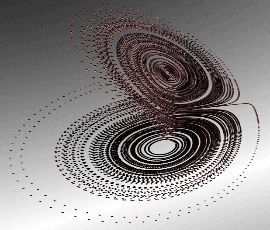Introduction to mathematical physics, fall 2012
Introduction to mathematical physics, fall 2012
Introduction to dynamical systems and chaotic systems
Lecturer
Carlos Mejia-Monasterio
Paolo Muratore-Ginanneschi
Scope
10 cu.
Type
Advanced studies
Course description
Dynamical systems are mathematical models describing the evolution of systems in terms of equation of motion and initial values. Examples are mechanics in physics, population dynamics in biology and chemical kinetics in chemistry. Dynamical systems theory is also finding an increasing number of applications in social sciences as mathematical economy and finance.
The course will focus on models based on ordinary differential equations (ODE). Under rather general conditions, ODE are known to have unique solutions for any complete set of initial data. In the general case of non-linear dynamics, fully deterministic solutions may become unpredictable for practical purposes due a to sensitive dependence on the initial conditions. This striking phenomenon is called chaos .
The purpose of the course is to illustrate tools and techniques to characterize qualitative properties of the solutions like dependence on initial data, large time behavior and sensitivity to variation of the parameters. Reduction and perturbative methods for quantitative construction of the solutions will be also illustrated.
The emphasis of the course will be on concrete examples and geometric thinking. Theorems will be stated but the main interest will be to show their meaning and relevance in the treatment of concrete examples.
Contents
Linear systems, fixed points and cycles in 2-D, simple bifurcations in 2-D, flows in 3-D chaos and Ljapunov exponents. Methods for simplifying dynamical systems: central manifold, normal forms and multi-scale perturbation theory.
Prerequisites
The course is intended for undergraduate students of mathematics, physics. Prior courses in advanced calculus and linear algebra are required (Diff.Int. 1-2 and Lineaarialgebra 1, or Mapu 1-2). Background material will be on request discussed during the course.
Lectures
Weeks 37-42 and 44-50, Tuesday 14-16 and Thursday 14-16 in room C123.
From 12.11 exercises on Mondays 14-16 in room CK108. Last exercise session 25.11.
First lecture: Tuesday 11.09
The lecture notes cover and sometimes integrate the material expounded in the lessons.
They also give bibliographic references for the same topics. Note that, however, the subdivision of the lecture notes
does not necessarily reflects the number of taught lessons.
Lectures 1-10 | Lectures 10-20 |
|---|---|
Existence and uniqueness of solutions (17.09) | Periodic orbits (27.11) |
Time-autonomous linear systems (18.09) |
|
Time-non-autonomous linear systems (26.11) |
|
Hamiltonian systems (27.09) |
|
Fixed point stability (02.10) |
|
Invariant manifolds I (02.10) |
|
Invariant manifolds II (12.10) |
|
Normal forms theory (20.10) |
|
Lyapunov exponents (19.11) |
|
Billiard tables (19.11) |
|
Attachment to lectures |
|
|---|---|
A Mathematica notebook for the forced pendulum |
|
Exams
Bibliography
The main references for the course are
- Chaos: From Simple Models to Complex Systems by Massimo Cencini, Fabio Cecconi and Angelo Vulpiani (2009),
- Concepts and Results in Chaotic Dynamics by Pierre Collet and Jean-Pierre Eckmann (2006),
- Geometrical theory of dynamical systems, Nils Berglund (2001),
- Perturbation theory of dynamical systems, Nils Berglund (2001)
References for numerical exercises
- GNU Octave documentation
- Lecture Notes for the Octave class at BFH-TI by Andreas Stahel
- Octave wiki tutorial
- Introduction to Octave by P.J.G. Long (2005)
Octave packages can be retrieved also from
Registration
Did you forget to register? What to do.
Exercise groups
Group | Day | Time | Place | Instructor |
|---|---|---|---|---|
1. |
|
|
|
|